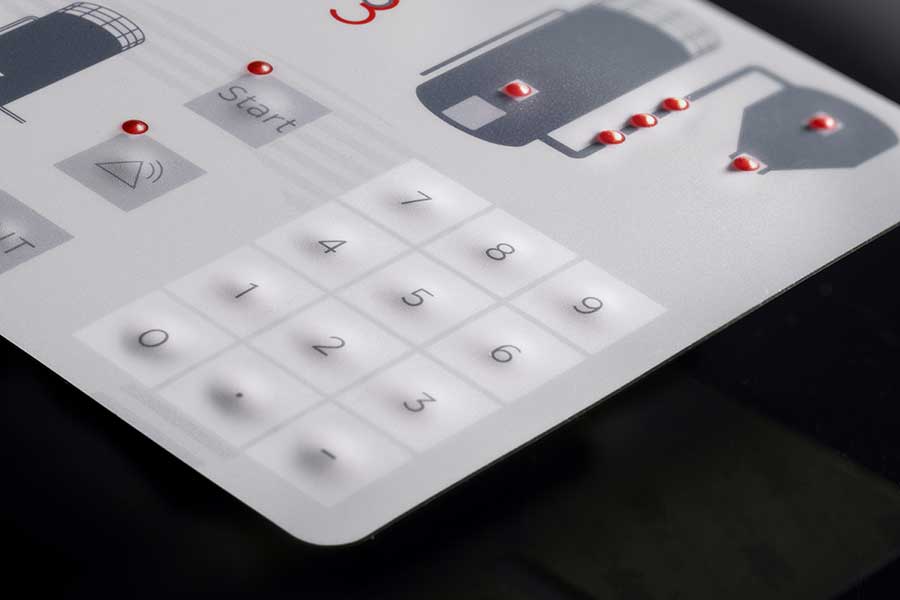Discover Different Types of Membrane Switch Technologies for Your Demands
Discover Different Types of Membrane Switch Technologies for Your Demands
Blog Article
Understanding the Capability of Membrane Changes for Individual Interface Devices
The functionality of membrane layer changes represents a significant advancement in interface style, combining performance with aesthetic versatility. These switches operate through a multi-layered framework that translates individual interactions into electric signals, allowing for both portable designs and resilience versus ecological aspects. As markets significantly prioritize customer experience, comprehending the subtleties of membrane layer button innovation comes to be necessary. What ramifications do these innovations hold for future applications, and exactly how might they redefine customer communications across various gadgets?
What Are Membrane Layer Buttons?
Membrane layer switches are innovative user interface gadgets that assist in customer communication with digital devices. These versatile components include multiple layers, including a graphic overlay, spacer, and a printed circuit layer. The style enables a seamless integration into various electronic devices, improving both the visual and practical elements of individual interfaces.
Membrane switches are typically utilized in a large range of applications, from home appliances to industrial equipment and medical gadgets. Their construction generally features a thin account, making them an excellent selection for portable layouts. The responsive comments offered by these switches can be crafted to satisfy particular individual preferences, ensuring reliable interaction between the user and the tool.
Toughness is an additional significant advantage of membrane buttons, as they are resistant to dust, dampness, and chemicals, which enhances their life-span in requiring atmospheres. Additionally, these buttons can be personalized in terms of form, dimension, and graphic layout, permitting for branding and user-specific functions. Overall, membrane layer changes represent a useful option for improving user experience in digital devices, incorporating performance with visual charm in an efficient way.
How Membrane Layer Switches Work
Operating on a simple concept, membrane switches use a split building to sign up customer input effectively. Each button consists of numerous layers, including a published circuit layer, a spacer layer, and a leading graphic layer, which are developed to interact effortlessly. When a user presses the top layer, it presses the spacer layer, bringing the conductive elements of the circuit layer into call with each other.
This get in touch with develops a closed circuit, indicating the tool to perform a certain function. The style permits for numerous configurations, consisting of responsive feedback, which can enhance the customer experience by providing a physical feeling upon activation. The products made use of in membrane switches often consist of adaptable substratums, such as polyester or polycarbonate, which guarantee resilience and durability against wear and tear.

Key Benefits of Membrane Layer Buttons

An additional considerable advantage is their density. Membrane switches are thin and lightweight, which makes it possible for makers to save area in their devices without giving up performance. This feature is specifically valuable in applications where weight and volume are crucial factors to consider.
Furthermore, membrane layer switches are resistant to dust, dampness, and chemicals, enhancing their durability. This durability prolongs their lifespan and lowers the requirement for constant replacements, causing cost financial savings over time.
In addition, the responsive feedback supplied by membrane layer switches can be enhanced to boost user communication. They can include attributes such as raised buttons or distinct clicks, improving usability and individual experience.
Applications Throughout Industries
User interface tools making use of membrane buttons are common in a vast variety of sectors, showcasing their adaptability and performance. Membrane Switch. In the clinical field, membrane layer switches are important to devices such as analysis equipment and person tracking systems, where their resilience and simplicity of cleansing are critical for keeping health standards. Similarly, in the automobile market, these buttons are utilized in control panel controls and infomercial systems, providing a smooth and modern-day user interface for customers.
Additionally, the customer electronic devices field advantages from membrane layer buttons in home appliances and handheld devices, where compact design and straightforward user interfaces boost customer experience. Industrial applications additionally take advantage of membrane changes for control board in equipment and automation systems, highlighting their toughness and resistance to severe settings.
In the aerospace and protection markets, membrane buttons are utilized in cabin controls and tools, where dependability and performance under severe problems are extremely important. Additionally, the pc gaming sector progressively integrates membrane buttons in controllers and game machines, adding to an click for source interesting customer experience. Overall, the right here flexibility of membrane switches allows their extensive usage across numerous industries, emphasizing their importance in modern individual interface design.
Future Fads in Membrane Change Innovation

Furthermore, making use of innovative materials, such as polycarbonate and polyester films, is expected to increase, providing enhanced toughness and resistance to environmental stressors. These products contribute to the general durability of membrane layer buttons, making them appropriate for harsher commercial applications.
Moreover, the consolidation of wise innovation, consisting of IoT connection, will certainly make it possible for membrane layer buttons to interact with various other tools and systems, helping with a much more interactive individual experience. This pattern straightens with the expanding need for clever tools throughout numerous fields, from healthcare to customer electronic devices.
Lastly, personalization choices are expected to expand, allowing manufacturers to create bespoke solutions customized to particular customer requirements and preferences. These developments will certainly place membrane layer switches as crucial components in the evolution of individual interface modern technology.
Verdict
In conclusion, membrane layer switches over represent a pivotal improvement in user interface innovation, offering a trustworthy and versatile option for varied electronic applications. As innovations in material scientific research and touch picking up technologies proceed, the capability and applicability of membrane switches are anticipated to broaden, enhancing their importance in modern-day digital devices.
Report this page